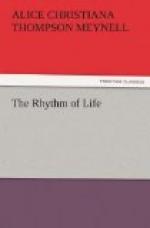They knew that the flux is equal to the reflux; that to interrupt with unlawful recurrences, out of time, is to weaken the impulse of onset and retreat; the sweep and impetus of movement. To live in constant efforts after an equal life, whether the equality be sought in mental production, or in spiritual sweetness, or in the joy of the senses, is to live without either rest or full activity. The souls of certain of the saints, being singularly simple and single, have been in the most complete subjection to the law of periodicity. Ecstasy and desolation visited them by seasons. They endured, during spaces of vacant time, the interior loss of all for which they had sacrificed the world. They rejoiced in the uncovenanted beatitude of sweetness alighting in their hearts. Like them are the poets whom, three times or ten times in the course of a long life, the Muse has approached, touched, and forsaken. And yet hardly like them; not always so docile, nor so wholly prepared for the departure, the brevity, of the golden and irrevocable hour. Few poets have fully recognised the metrical absence of their Muse. For full recognition is expressed in one only way—silence.
It has been found that several tribes in Africa and in America worship the moon, and not the sun; a great number worship both; but no tribes are known to adore the sun, and not the moon. For the periodicity of the sun is still in part a secret; but that of the moon is modestly apparent, perpetually influential. On her depend the tides; and she is Selene, mother of Herse, bringer of the dews that recurrently irrigate lands where rain is rare. More than any other companion of earth is she the Measurer. Early Indo-Germanic languages knew her by that name. Her metrical phases are the symbol of the order of recurrence. Constancy in approach and in departure is the reason of her inconstancies. Juliet will not receive a vow spoken in invocation of the moon; but Juliet did not live to know that love itself has tidal times—lapses and ebbs which are due to the metrical rule of the interior heart, but which the lover vainly and unkindly attributes to some outward alteration in the beloved. For man—except those elect already named—is hardly aware of periodicity. The individual man either never learns it fully, or learns it late. And he learns it so late, because it is a matter of cumulative experience upon which cumulative evidence is lacking. It is in the after-part of each life that the law is learnt so definitely as to do away with the hope or fear of continuance. That young sorrow comes so near to despair is a result of this young ignorance. So is the early hope of great achievement. Life seems so long, and its capacity so great, to one who knows nothing of all the intervals it needs must hold—intervals between aspirations, between actions, pauses as inevitable as the pauses of sleep. And life looks impossible to the young unfortunate,




